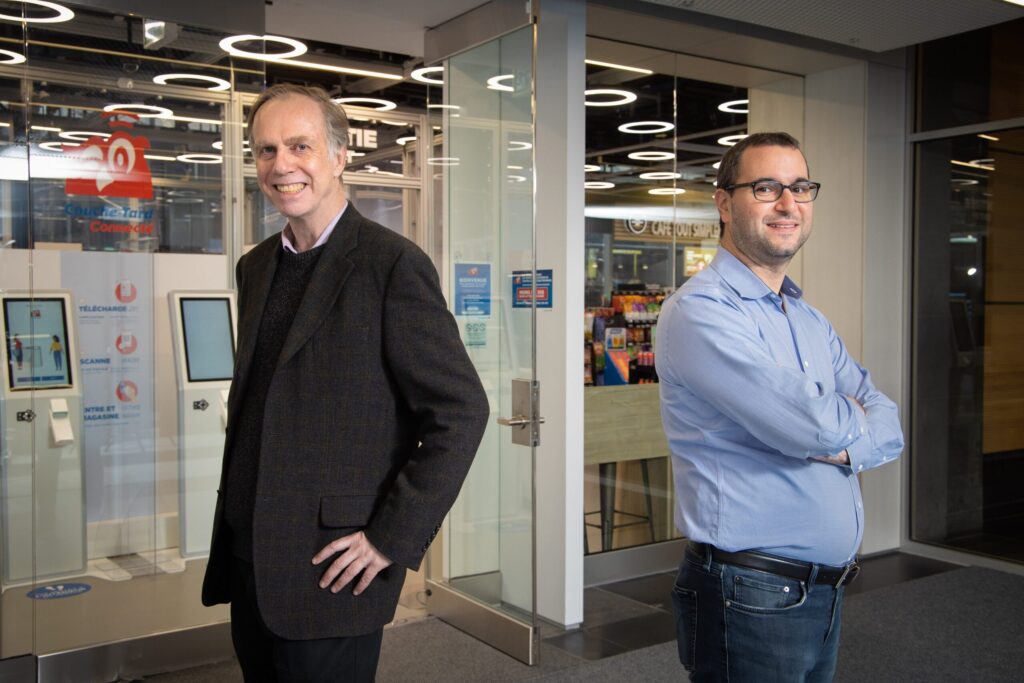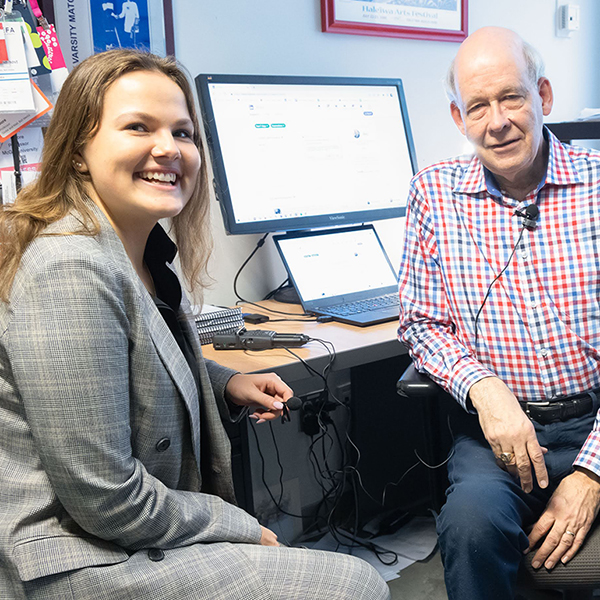From the outside, the convenience store on the ground floor of McGill’s Bronfman Building looks like any other Couche-Tard franchise in Quebec. But inside, there’s a ground-breaking research facility hoping to shape the future of retail innovation by better understanding consumer behaviour through technology.
Customers can pick up a sandwich or a pack of gum while contributing to a research project or two.
The Retail Innovation Lab, a partnership between McGill’s Bensadoun School of Retail Management and Alimentation Couche-Tard, opened in early 2021. It’s one of just five live laboratory stores in North America and the first frictionless store in Canada, says the lab’s co-director, Maxime Cohen, a professor of retail and operations management at the Desautels Faculty of Management and McGill’s SCALE AI Chair in Data Science for Retail.
“The lab allows us to conduct impactful state-of-the-art research on retail management that’s bridging the gap between academics and practitioners,” says Cohen.
“We’re researching futuristic, modern retail practices to improve the customer experience in convenience store settings, while keeping a strong focus on social responsibility, ethics and sustainability.”
This ‘living lab’, which collects data that can be used for research and teaching purposes, is also the first of its kind that’s open to the public, in partnership with university academics, adds Zahoor Chughtai, the lab’s projects and operations manager.
“Unlike other retail labs that have a more controlled environment where the retailer decides who participates and how they collect the data, our living lab exists in a very naturalistic environment, where everyone walking in participates in the research. We’re collecting real customer data reflective of their true behaviour,” he explains.
The lab is focused on responsible innovation, where customer privacy is paramount, says lab co-director James Clark, a professor of electrical and computer engineering and a former director of the McGill Centre for Intelligent Machines. Although cameras track customer movements and choices as they move through the store, there’s no facial recognition, names or credit card number logged because the lab uses blurred personalization models.

“When you’re tracking people in stores, you don’t want to have any individual information. Our information is anonymized and, in many cases, aggregated over groups,” explains Clark.
“We want to look at the behaviour of different groups and record the trajectories – a map of the pathway they take during their visits. Some make a beeline to the coffee machine and then leave. Others explore the whole store or go to a few places, and we can correlate that with what they buy.”
A special section within the store, Couche-Tard Connecté, lets users scan an app on their smartphones at the entrance terminal so they can make frictionless purchases. Computer vision systems recognize the grab-and-go items in real time, processing payment digitally so customers can be in and out of the store in minutes. Having delayed the lab’s opening due to the pandemic, the team was not only able to fine-tune the space, but also tap into consumers’ growing desire for an efficient, touchless and convenient experience, says Chughtai.
“We couldn’t have planned it better; the COVID period forced customers to be careful in terms of interaction, social distancing, and hygiene measures, so having a frictionless section in the store is timely,” he notes.
“There’s no lineup or interaction with the cashier; you just walk in, put your phone in your pocket, do your shopping and leave.”
Clark’s main research focus over the past 20 years has been on modelling human attention and developing machine learning models that can predict or analyze it. The retail innovation lab is an ideal setting for such research, he notes.
“It’s similar to heat maps of people looking at webpages to see what they pay attention to and then adjusting the page layout,” he explains. “In the store, we can lay out products in different ways on the shelves, depending on what we see they buy. We’re also looking at what people get distracted by, so we’re building some models for that.
Several research projects are already underway, says Cohen.
One area being studied encourages consumers to choose healthier food and drinks through experimental layout design, strategic placement and customized mobile messaging. When customers have the munchies, can they be gently encouraged to buy fruit instead of a candy bar? Using machine learning, predictive algorithms, biostatistics and econometrics, researchers will evaluate data to learn more about shoppers’ behaviour.
A collaboration with McGill’s Department of Electrical and Computer Engineering had students build a prototype called Visual Product Search. “You come to the store with your smartphone, take a picture of any product and an AI algorithm tells you the nutritional content and price, for example,” Cohen says.
Cohen’s team is also doing a planogram optimization project, which varies the location of products on a shelf over time to measure how placement affects consumer buying behaviour. And plans are in the works to build a digital twin for the store, where people can virtually shop using augmented and virtual reality.
“It’s very futuristic and ambitious, but we’re very excited to launch this product in the next year, and we’ve already recruited a post-doctoral fellow to work on it,” says Cohen.
In addition to improving customer experience, the data collected in the lab can help improve business operations such as inventory management and staff planning.
“To my group of researchers, this lab provides a testing ground and new application areas: It has real data for real problems, which is great for engineering,” says Clark, adding that the lab is valuable to students because it shows them how and where class material can be used in real-world practice.
“I think the next stage of this new machine and deep learning revolution is moving out of the lab into industry as everyday applications so it becomes ubiquitous, and there’s a lot we can offer as developers,” says Clark. “And because these applications have constraints and problems that need to be solved, we may learn new things that can help us develop new theories and techniques.”


